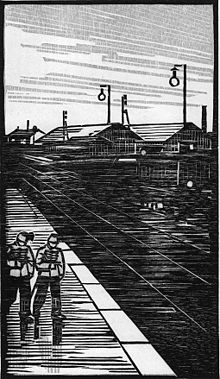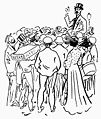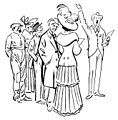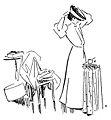Charles Émile Egli
Charles Émile Egli | |
|---|---|
| Born | 30 March 1877 Aigle, Switzerland |
| Died | 11 January 1937 (aged 59) Paris, France |
| Nationality | Swiss, French |
| Occupation | Engraver |
Charles Émile Egli (known as Carlègle; 30 March 1877 – 11 January 1937) was a Swiss-born illustrator and painter who spent most of his life in Paris.
Early years[]

Charles Émile Egli was born in Aigle, Switzerland on 30 March 1877.[citation needed] He was educated in Aigle and then at the college of Vevey. When he was eighteen he attended engraving classes of Alfred Martin at the school of industrial arts in Geneva. Four year later he moved to Paris, where he stayed the rest of his life. Egli studied at the École des Beaux-Arts.[1]
Career[]
Egli adopted the pseudonym of Carlègle. He soon became known in satirical journals like Le Rire, Le Sourire, La Vie Parisienne, L'Assiette au Beurre, Fantasio, La Gazette do Bon Ton, Les Humoristes and Qui lit rit. Egli excelled in wood engraving. His illustrations for Daphnis et Chloé exhibited in the autumn Salon of 1913 launched his career. From then until his death in 1937 he illustrated books by classical and contemporary authors such as Virgil, Paul Valéry, Blaise Pascal, Paul Verlaine, Anatole France and Charles Maurras. He was naturalized in 1927.[1]
Charles Émile Egli died in Paris on 11 January 1937. He was the subject of a book by Hugues Delorme published in 1939.[2]
Selected works[]
Books that Egli illustrated include:
- Carnet d'un Combattant by , Payot - appeared in 1917, under the pseudonym of lieutenant E.R., with 64 pen drawings
- Frontispice in the review L'Encrier, founded by in May 1919
- La Petite Fille aux Papillotes, original wood engraving in the review L'Encrier (15 October-15 November 1919)
- Daphnis et Chloé by Longus, chez Pichon in 1919
- Le Train de 8h47 by Georges Courteline, Paris, Société littéraires de France
- Les Linottes by Georges Courteline, Paris, Éditions littéraires de France
- Les Aventures du Roi Pausole by Pierre Louys, first published by Fayard (« Modern Bibliothèque ») in 1908, then with different illustrations by Briffaut in 1924
- Mon Amie Nane by Paul-Jean Toulet, 18 original wood engravings, Paris, Léon Pichon, 1925
- Les Contrerimes by Paul-Jean Toulet, 6 original wood engravings, Brussels, Editions Un Coup de Dés, 1927
- Lysistrata d'Aristophane, Paris, Éditions Briffaut, 1928
- Maxime de Duvernois, Babou, 1929
- Le Sopha de Crébillon, Mornay, 1933
- Nudité de Colette, La Mappemonde, 1943 (posthumous)
- L'Arlequin aux Jacinthes by Maurice Venoize, Boivin et Cie, undated
Engravings from Les Linottes[]
References[]
Citations
- ^ Jump up to: a b Chatelain 2008, p. 90.
- ^ Flers 1922.
| Wikimedia Commons has media related to Carlègle. |
Sources
- Chatelain, Roger (2008). La typographie suisse du Bauhaus à Paris. Collection le savoir suisse. ISBN 978-2-88074-771-8. Retrieved 2014-02-05.
- Flers, Robert de (1922). Hugues Delorme chez les fées.
- 1877 births
- 1937 deaths
- 20th-century French painters
- 20th-century male artists
- French male painters











